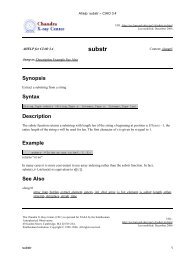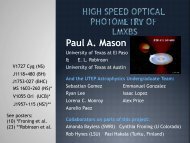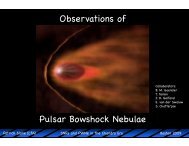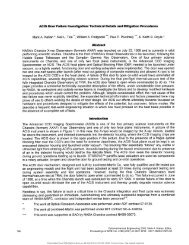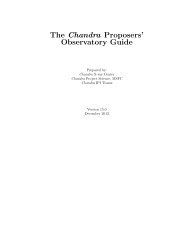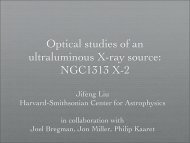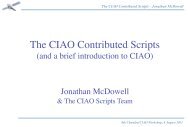Paper Title - Chandra X-Ray Observatory (CXC)
Paper Title - Chandra X-Ray Observatory (CXC)
Paper Title - Chandra X-Ray Observatory (CXC)
You also want an ePaper? Increase the reach of your titles
YUMPU automatically turns print PDFs into web optimized ePapers that Google loves.
The mission planning system delivered at launch, the Offline System (OFLS) was designed to schedule all<br />
observations in accordance with the CARD and with constraints specified in the OR. However, very soon<br />
after launch, things started to change. Within the first few orbits of science operations, ACIS started<br />
incurring damage from low energy protons. This observed damage led to a new scheduling constraint that<br />
was not anticipated before launch, and, therefore, not incorporated into the ground system. Later followed<br />
changes to, among other items, scheduling of OTG moves, restrictions to the number of momentum<br />
unloads allowed and restrictions on the temperatures of various units. Each constraint change required an<br />
adjustment to the way the mission was scheduled. The <strong>Chandra</strong> scheduling process, therefore, by<br />
necessity, became adaptable and flexible.<br />
While the precise issues facing <strong>Chandra</strong> are not likely to re-occur on other missions, most spacecraft will<br />
reach a point where they must be operated by a new and changing set of rules. This paper will walk<br />
through the <strong>Chandra</strong> scheduling process, highlighting lessons learned and best practices that could aid other<br />
missions in preparing for the inevitable parameter space change caused by vehicle age, on-orbit experience,<br />
environmental exposure, and changing resources and expectations.<br />
2. Nominal Mission Scheduling Process<br />
2.1. Process Overview and Goals<br />
<strong>Chandra</strong> mission scheduling is performed on a week by week basis. Each weekly schedule includes all of<br />
the maneuver and reconfiguration commanding required to perform each observation and to safely stow the<br />
instruments when passage through the Van Allen belts makes the radiation environment too hostile to<br />
observe. Responsibility for mission scheduling is spilt between Science Operations Team (SOT) and Flight<br />
Operations Team (FOT) Mission Planners. FOT Mission Planning performs the detailed level scheduling<br />
that that turns an unordered list of observations into a weekly observing schedule and finally command<br />
loads. This detailed level scheduling will be the focus of this paper.<br />
The detailed scheduling process aims to generate optimal schedules for <strong>Chandra</strong> that meet all spacecraft<br />
health and safety constraints, meet science constraints of the observations and respect preferences of<br />
observers as much as possible. <strong>Chandra</strong> mission scheduling takes a heuristic approach to solving the<br />
problem of optimizing observing schedules. Schedules are manually ordered using the follow list of<br />
priorities: (1) Spacecraft Safety, (2) Science Goals, (3) Maximize Time for Science, (4) Minimize use of<br />
consumables. <strong>Chandra</strong> is fortunate in that at their current rate of use consumables will last beyond the<br />
planned duration of the mission, so use of consumables can be prioritized below science objectives.<br />
2.2. Process Description<br />
Every year, once the call for proposals is complete and the peer review process recommends targets for<br />
observation, approved observations are translated into ORs. The ORs are laid out into a yearly observing<br />
plan, binned by week. This yearly plan is called the Long Term Schedule (LTS). Layout of the LTS is the<br />
first step toward generating efficient weekly schedules. First, the observations that are short and have no<br />
observing constraints are pulled out into the “pool”. Pool targets are not assigned to any given week, but<br />
are instead used to fill in around constrained and long observations, improving efficiency. All remaining<br />
observations are placed into a particular week of the year, based on science constraints specified in the OR<br />
and on availability of the specified target within vehicle constraints during that week.<br />
Each week the targets scheduled in the LTS are put into an OR list that is delivered to the Flight Operations<br />
Team (FOT) Mission Planners. FOT Mission Planning then performs the detailed scheduling that turns an<br />
unordered list of observations into a weekly observing schedule and finally command loads. The mission<br />
scheduling software provided to the FOT Mission Planners at launch was designed as a “black box” that<br />
could ingest ORs and Engineering Requests (ERs) and output efficient mission schedules. An optimization<br />
routine with knowledge of spacecraft and observation constraints would do most of the work of mission



